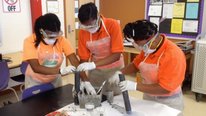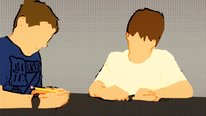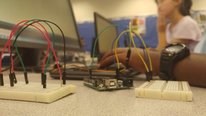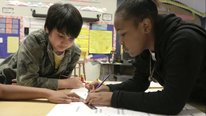- Martina Nieswandt
- Associate Professor
- Managing Small Groups to Meet Psychological and Social Demands of High School Science
- http://www.umass.edu/highschoolscience
- University of Massachusetts Amherst
- Elizabeth McEneaney
- Associate Professor
- Managing Small Groups to Meet Psychological and Social Demands of High School Science
- http://www.umass.edu/highschoolscience
- University of Massachusetts Amherst
Public Discussion
Continue the discussion of this presentation on the Multiplex. Go to Multiplex








Elizabeth McEneaney
Associate Professor
A couple of things to think about as you learn about our research project:
1) Is small group work an essential part of learning science and engineering at the high school level?
2) If so, should science teachers teach students how to work effectively in groups or should students learn it some other way?
Thanks for stopping by!
Richard Hudson
Senior Executive Producer
Project asks very interesting questions about collaborative STEM learning. The graphics display the multi-dimensional approach being used in the research. I’d love to see more of the videos, and learn more about the video analysis process. What are the criteria you use to color-code the videos during your analysis?
Elizabeth McEneaney
Associate Professor
Unfortunately, our consent forms were not written to allow us to contribute the raw videos to a video data bank for secondary analysis. We are using short clips in conference presentations, and ideally will publish some results in online journals that would allow readers to link to the clip we refer to in the article.
I will say that working with video (100s of hours worth) has taken more time than we thought. We are not doing full transcriptions (audio is difficult to discern sometimes in any event), but rather are relying on “elaborated running records” for qualitative analysis, and the sequence analysis approach to quantize the qualitative video data.
The color coding we showed for our “sequence analysis” of group process is based on our coding of the group’s level of behavioral, cognitive and social engagement. The sequence analysis is being led by one of our doctoral students, Miancheng Guo, who is particularly looking at sequence patterns for gender sub-groups for his dissertation. Thanks for your interest, Richard!
Richard Hudson
Senior Executive Producer
I think the field of STEM media producers might be very interested in a paper on the methodology alone, separate from your findings. Good opportunity for Miancheng Guo to get a publication!
Miancheng Guo
Yes Richard, I will cherish this opportunity. Also, thanks for mentioning that the field of STEM media producers could be a direction to go!
Robert Tinker
This project provides an interesting lens on learning in groups. Of course, the biggest problem with groups involves the roles students take on and how the roles are adopted and rotated. Freeloading and dominating are common problems that can interfere with learning. If you pick groups at random, you may not learn much new from malfunctioning groups. How are you dealing with this problems?
Martina Nieswandt
Associate Professor
We put students into groups based on their level of interest in biology and the biology class (low vs. high interest). Students’ interest was assessed with a short questionnaire at the beginning of the school year; total scores determined low or high interest level.
We analyze group behavior in three dimensions (social/relational, affect, and cognitive), which allows us to understand what is happening in groups, who does what, who is “freeloading and dominating” and how this results in group dynamic.
Brian Drayton
Fascinating questions, and sounds like you are gathering some really valuable data (I hope it’s been written up someplace, I want to share it with some colleagues).
Have you based your work on comparable studies of expert teams? For example, you remark on the volatility (along all 3 dimensions), and my experience in small research groups of adults is that this is also a feature— perhaps the tempo is a bit slower but not always! I would wonder if intensity relates to condition of the task — that is, when people get into model-building (especially at the brainstorming or debugging stages), or when a possible breakthrough on a persistent problem seems to be emerging- that sort of thing.
Martina Nieswandt
Associate Professor
Thank you for you comment and we are happy that you are interested in reading more about our results and share it with your colleagues. We have a short paper published and more is in the pipeline.
The question of the task condition or type of task is something we are investigating (inquiry-based science vs. engineering design). We also look particularly within engineering design, how different steps of engineering design are related to group dynamics along all three dimensions. One of our doctoral students in our team is focusing his dissertation on this aspect.
Miancheng Guo
Yes Brian, in my preliminary study I did find patterns similar to what you described (I am the doctoral student that Martina mentioned), and I found that such variations were not only related to the specific engineering design steps, but also to the gender composition of the student group.
For example, in the case that I studied (four groups with different boy-girl ratios), in the conceptual design (brainstorming) step both girls’ and boys’ behavioral, emotional and cognitive engagement levels were high, but when the groups entered into embodiment design (construction of prototype), in gender-parity and female-minority groups boys got even more active with some typical male-pattern behaviors while in contrast girls’ emotional and cognitive engagement levels obviously faded.
Brian Drayton
I have one thought about “teaching small group work.” Purely from observation over the years: Most of such teaching is fairly artificial, aiming at division of labor in some at-first-reasonable but in-fact-not-functional way. But having the students discuss their team’s functioning from time to time, according to a few key criteria, as sometimes happens in the workforce or on sports teams, etc. could equip them to create their own balances. The longer I work in teams, the more I realize how team health is a whole project in itself!
Elizabeth McEneaney
Associate Professor
Yes, this project is very much confirming that idea for me as well, even if kids have been working in small groups since elementary school. The support needed for good group functioning needs to be tailored to developmental level, I think, and probably to subject too. So… how a teacher supports 3rd graders would be different than 9th graders, and how one supports group work in math or English differs from science (and engineering design).
About the ‘artificiality’ — I think kids too sort of know these days how to make their group seem “reasonable.” And they know that the work is supposed to be shared, and that they’re supposed to brainstorm. It’s been interesting to compare what group members say about their group functioning in focus group interviews versus what we as researchers saw in the videos.
Jerry Valadez
CEO
Wow! I also would like to see the results of the study. How did you come up with the rubric for your sequence analysis to code these processes? What is the role of student interaction? Is student talk (science discourse or engineering discourse) also considered in the design? I remember long ago when I was observed by a principal and found my class ‘too noisy’ for learning to happen. I was in fact having students work in groups and the discourse was all about the lab they had just done. I scolded him back because he didn’t stop to listen to what the students were talking about.
I applaud you efforts and look forward to your results.
Elizabeth McEneaney
Associate Professor
We’re working on inter-rater reliability for the sequence analysis, but the basic coding at the moment is level of engagement (100% of group, 75%, etc) — and we look at behavioral engagement, social and cognitive engagement. The social engagement piece would definitely involve interaction between students — could be talk, but also looking at each other, etc.
I completely agree that when the groups really get going — really talking to each other, exploring materials, etc, not just checking in with each other about how to fill out a worksheet — the room is noisy. We need to coach administrators about what academically productive science classrooms are like!
Further posting is closed as the showcase has ended.